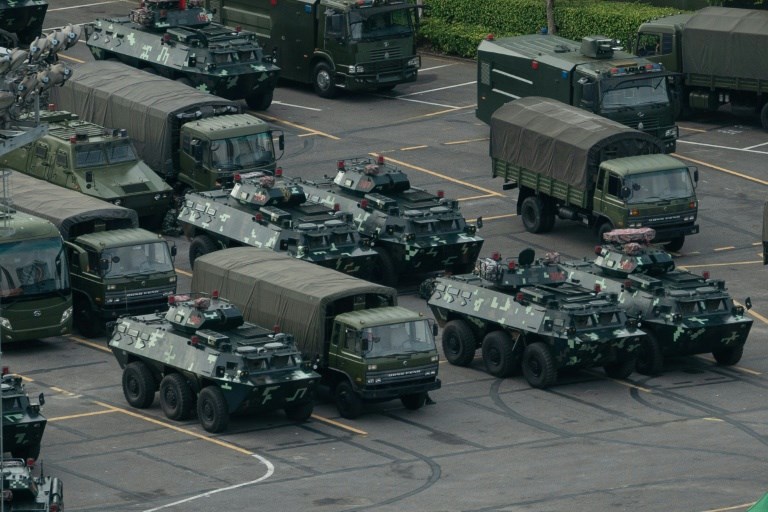China has deployed a three-pronged strategy to suffocate pro-democracy protests in Hong Kong -- propaganda, economic leverage and intimidation.
Here is a look at Beijing's efforts so far to squash a movement that has refused to die.
- Shaping the narrative -
As protests erupted in June, discussion inside authoritarian China was muted, censored on social media or played down on state outlets.
But as chaos unfurled across Hong Kong, Beijing changed tack seeking to shape the narrative in its favour.
After a tense airport siege, which saw protesters assault two Chinese nationals accused of being "spies", Beijing ramped up the rhetoric saying protesters were guilty of "terrorist-like actions".
Inside China's "Great Firewall", where Facebook and Twitter are banned and information controlled, Hong Kong's protests are now being portrayed as a largely violent, foreign-funded plot to destabilise the motherland.
But recasting the protesters as a rabble rather than a movement with legitimate concerns over China's influence over Hong Kong, is not just for domestic consumption.
On Monday American tech giants Twitter and Facebook said they had suspended nearly 1,000 active accounts linked to a social media campaign emanating from China and aimed at undercutting the legitimacy of the Hong Kong protest movement.
Twitter said it had shut down a further 200,000 accounts before they could inflict any damage.
Chinese ambassadors have hit global television networks to decry the protesters.
Meanwhile, editorials in Chinese newspapers this week gave a glowing spin to vague allusions by Hong Kong's beleaguered leader to engage in a dialogue with the movement - words widely criticised as empty inside the city.
- Money matters -
The world's second-largest economy has also used its economic might to try to drain support for the protests, rattling businesses across Hong Kong, a freewheeling financial hub.
Most prominently, Hong Kong airline Cathay Pacific faced censure after some of its 27,000 strong workforce joined - or voiced support - for the rallies.
China's aviation regulator demanded that the airline prevent staff who openly supported protests from working on flights to the mainland or those routed through Chinese airspace.
With its share price in freefall, the airline's CEO resigned last Friday at the end of a torrid week.
China's indignant social media lit up in outrage at the airline - the hashtag #boycottcathaypacificairline has racked up tens of millions of views.
Analysts say the incident sent a shudder through Hong Kong corporations, most of whom have major business ties with China.
A Taiwanese bubble tea franchise and a popular Japanese sports drink have also felt online fury, while the so-called 'Big Four' accounting firms in Hong Kong have been hammered for a perceived failure to take to task employees who crowdfunded an ad in support of the protests.
Beijing has also enlisted pro-China tycoons in Hong Kong as part of efforts to control local opinion.
Hundreds of pro-Beijing business figures and lawmakers signed an open letter supporting Carrie Lam and her embattled government published on the front page of a pro-Beijing newspaper.
"Of course, it is easier to convince the businessmen because they have a lot of interests in mainland China," said Ivan Choy, a senior lecturer at the Chinese University of Hong Kong.
"But it is not for example easy to convince the academics, to convince the public opinion leaders to do the same thing."
- Intimidation tactics -
As violence intensified so did the messaging from the central Chinese government with the threat of a crackdown by mainland security forces stalking the protests.
At the end of July, the garrison of the People's Liberation Army stationed in Hong Kong released a video showing an anti-riot drill in which soldiers with assault rifles, armoured personnel carriers and water cannons disperse a crowd of protesters.
Last week thousands of Chinese military personnel waving red flags paraded at a sports stadium in Shenzhen, a Chinese city across the border from Hong Kong.
A video of lines of armoured personnel carriers backed by chest-thumping patriotic song was also pumped around state media.
The videos aimed "to ratchet up the psychological warfare and serve as warning to the protesters that these troops... are very close to Hong Kong and they can be deployed anytime Beijing wants," said political analyst Willy Lam of Chinese University of Hong Kong.



